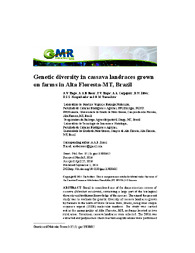Genetic diversity in cassava landraces grown on farms in Alta Floresta-MT, Brazil.
Genetic diversity in cassava landraces grown on farms in Alta Floresta-MT, Brazil.
Author(s): TIAGO, A. V.; ROSSI, A. A. B.; TIAGO, P. V.; CARPEJANI, A. A.; SILVA, B. M.; HOOGERHEIDE, E. S. S.; YAMASHITA, O. M.
Summary: Brazil is considered one of the domestication centers of cassava (Manihot esculenta), containing a large part of the biological diversity and traditional knowledge of the species. The aim of the present study was to evaluate the genetic diversity of cassava landraces grown by farmers in the north of Mato Grosso State, Brazil, using inter simple sequence repeat (ISSR) molecular markers. The study was carried out in the municipality of Alta Floresta, MT, on farms located in two rural areas. Seventeen cassava landraces were selected. The DNA was extracted and polymerase chain reaction amplifications were performed using 15 ISSR primers. Genetic similarity estimates were calculated using Jaccard?s index and the generated matrix was used for clustering the genotypes by using UPGMA and Tocher?s methods. The 15 ISSR primers amplified 120 fragments, revealing 61.67% polymorphism. The polymorphism information content ranged from 0.04 to 0.61, averaging 0.39. The most similar genotypes were AF5 and AF8, whereas the least similar were AF1 and AF16. The UPGMA clustering method formed five groups. Group I included twelve landraces, Group II contained two, and the other groups contained one landrace each. Tocher?s method resulted in six groups: 12 landraces clustered in one group, and the other groups each contained one landrace. The ISSR markers proved efficient in revealing genetic diversity among the cassava landraces. The landraces grown by farmers in the two rural areas of Alta Floresta have a great variability and, thus, can be exploited in programs for breeding and preservation of the species.
Publication year: 2016
Types of publication: Journal article
Observation
Some of Embrapa's publications are published as ePub files. To read them, use or download one of the following free software options to your computer or mobile device. Android: Google Play Books; IOS: iBooks; Windows and Linux: Calibre.
Access other publications
Access the Agricultural Research Database (BDPA) to consult Embrapa's full library collection and records.
Visit Embrapa Bookstore to purchase books and other publications sold by Embrapa.

